Soil Organic Carbon Storage in Different Land Uses in Tropical Andean Ecosystems and the Socio-Ecological Environment
Abstract
1. Introduction
2. Materials and Methods
2.1. Site and Land-Use Description
2.2. Data Collection
2.2.1. Determination of Soil Carbon Inputs and Outputs
2.2.2. Soil Sampling
2.3. Laboratory Analysis
2.3.1. Soil Chemical Properties
2.3.2. Soil Physical Properties
2.4. Socio-Ecological Information Recompilation
2.5. Data Analysis
3. Results
3.1. C Inputs and Outputs and SOC Storage in Different Land Uses
3.2. Physicochemical Properties
3.3. Socio-Ecological Perception of Conservation and Environmental Priorities
3.3.1. Survey Information Collection Points and Environmental Preferences
3.3.2. Multinomial Logistic Regression
4. Discussion
4.1. Carbon Stocks
4.2. Soil Properties and SOC in Different Land Uses
4.3. Socio-Ecological Relationships Between Soil Variables and Conservation Perception
5. Conclusions
Author Contributions
Funding
Acknowledgments
Data Availability Statement
Conflicts of Interest
Correction Statement
Appendix A
| Plot | Land Use | BD (g/cm3) | HSM (%) | SM (%) | Sand (%) | Silt (%) | Clay (%) | pH | ECEC (meq/100 g) | SOC (Mg ha−1) | SBR (μg C-CO2 g−1 d−1) |
|---|---|---|---|---|---|---|---|---|---|---|---|
| RF1 | RF | 1.01 | 13.4 | 65.1 | 73.2 | 21.2 | 5.6 | 4.92 | 3.65 | 150.2 | 124.8 |
| RF2 | RF | 1.0 | 13.55 | 64.8 | 74.0 | 20.6 | 5.4 | 4.95 | 3.78 | 147.5 | 123.7 |
| RF3 | RF | 1.02 | 13.5 | 65.0 | 72.8 | 21.3 | 5.9 | 4.94 | 3.75 | 149.1 | 124.2 |
| RF4 | RF | 1.01 | 13.6 | 64.9 | 73.0 | 21.0 | 6.0 | 4.91 | 3.73 | 148.9 | 124.5 |
| ER1 | ER | 1.06 | 11.3 | 65.8 | 72.0 | 23.5 | 4.5 | 5.14 | 4.19 | 120.0 | 180.2 |
| ER2 | ER | 1.05 | 11.35 | 66.1 | 71.5 | 23.8 | 4.7 | 5.16 | 4.25 | 118.5 | 179.0 |
| ER3 | ER | 1.07 | 11.25 | 66.0 | 72.5 | 23.0 | 4.5 | 5.13 | 4.2 | 119.3 | 178.5 |
| ER4 | ER | 1.06 | 11.38 | 65.9 | 72.3 | 23.2 | 4.5 | 5.12 | 4.21 | 119.1 | 179.4 |
| NR1 | NR | 0.95 | 10.45 | 62.9 | 73.6 | 22.0 | 4.4 | 4.97 | 4.3 | 96.5 | 147.2 |
| NR2 | NR | 0.96 | 10.6 | 62.7 | 74.2 | 21.8 | 4.0 | 4.99 | 4.35 | 97.9 | 149.1 |
| NR3 | NR | 0.94 | 10.55 | 62.8 | 73.4 | 22.3 | 4.3 | 4.98 | 4.37 | 96.8 | 148.3 |
| NR4 | NR | 0.95 | 10.52 | 62.75 | 73.9 | 22.1 | 4.0 | 4.96 | 4.36 | 97.1 | 148.9 |
| LS1 | LS | 0.9 | 10.1 | 62.6 | 73.5 | 21.0 | 5.5 | 5.15 | 5.68 | 103.1 | 135.5 |
| LS2 | LS | 0.91 | 10.0 | 62.7 | 73.7 | 21.2 | 5.1 | 5.14 | 5.7 | 102.4 | 134.2 |
| LS3 | LS | 0.89 | 10.05 | 62.85 | 73.6 | 21.3 | 5.1 | 5.12 | 5.73 | 102.8 | 136.1 |
| LS4 | LS | 0.9 | 10.08 | 62.75 | 73.6 | 21.4 | 5.0 | 5.11 | 5.68 | 103.0 | 135.2 |
References
- Boakes, E.H.; Dalin, C.; Etard, A.; Newbold, T. Impacts of the global food system on terrestrial biodiversity from land use and climate change. Nat. Commun. 2024, 15, 5750. [Google Scholar] [CrossRef]
- Ivanovich, C.C.; Sun, T.; Gordon, D.R.; Ocko, I.B. Future warming from global food consumption. Nat. Clim. Change 2023, 13, 297–302. [Google Scholar] [CrossRef]
- Aguilar, K. Universidad de Murcia. All Rights Reserv. IJES 2020, 281, 1–30, Available online: https://digitum.um.es/digitum/bitstream/10201/93201/1/KarenLissetteAguilarDuarteTesisDoctoral.pdf. (accessed on 11 November 2024). [Google Scholar]
- Harper, A.B.; Powell, T.; Cox, P.M.; House, J.; Huntingford, C.; Lenton, T.M.; Sitch, S.; Burke, E.; Chadburn, S.E. Land-use emissions play a critical role in land-based mitigation for Paris climate targets. Nat. Commun. 2018, 9, 2938. [Google Scholar] [CrossRef] [PubMed]
- Anderson, E.P.; Marengo, J.A.; Villalba, R.; Halloy, S.R.P.; Young, B.E.; Cordero, D.; Gast, F.; Carrascal, E.J.Y.D.R. Consecuencias del Cambio Climático en los Ecosistemas y Servicios Ecosistémicos de los Andes Tropicales. Cambio Climático y Biodiversidad en los Andes Tropicales 2012, 426. Available online: https://rubielmontoya.wordpress.com/wp-content/uploads/2014/08/capitulo11.pdf (accessed on 11 November 2024).
- Sylvester, J.; Valencia, J.; Verchot, L.V.; Chirinda, N.; Romero Sanchez, M.A.; Quintero, M.; Castro-Nunez, A. A rapid approach for informing the prioritization of degraded agricultural lands for ecological recovery: A case study for Colombia. J. Nat. Conserv. 2020, 58, 125921. [Google Scholar] [CrossRef]
- Berrio-Giraldo, L.; Villegas-Palacio, C.; Arango-Aramburo, S. Understating complex interactions in socio-ecological systems using system dynamics: A case in the tropical Andes. J. Environ. Manag. 2021, 291, 112675. [Google Scholar] [CrossRef]
- Muñoz Gómez, F.A.; Galicia Sarmiento, L.; Pérez, E.H. Agricultura migratoria conductor del cambio de uso del suelo de ecosistemas alto-andinos de colombia. Biotecnoloía En El Sect. Agropecu. Y Agroindustrial 2018, 16, 15. [Google Scholar] [CrossRef]
- Krauss, M.; Wiesmeier, M.; Don, A.; Cuperus, F.; Gattinger, A.; Gruber, S.; Haagsma, W.K.; Peigné, J.; Palazzoli, M.C.; Schulz, F.; et al. Reduced tillage in organic farming affects soil organic carbon stocks in temperate Europe. Soil Tillage Res. 2022, 216, 105262. [Google Scholar] [CrossRef]
- Lal, R. Soil carbon sequestration impacts on global climate change and food security. Science 2004, 304, 1623–1627. [Google Scholar] [CrossRef]
- Lefévre, C.; Rekik, F.; Alcantara, V.; Wiese, L. Carbono Orgánico del Suelo. 2017. Available online: https://www.fao.org/publications/en (accessed on 1 November 2024).
- Barman, A.; Saha, P.; Patel, S.; Bera, A. Crop Diversification an Effective Strategy for Sustainable Agriculture Development. 2020. Available online: https://books.google.com/books?hl=es&lr=&id=HV17EAAAQBAJ&oi=fnd&pg=PA89&dq=Crop+Diversification+an+Effective+Strategy+for+Sustainable+Agriculture+Development&ots=LUJOOM6X8M&sig=QDhC8DWiYjfRh5RpKFpuCEZerFQ (accessed on 15 May 2023).
- Ordoñez, M.C.; Galicia, L.; Figueroa, A.; Bravo, I.; Peña, M. Effects of peasant and indigenous soil management practices on the biogeochemical properties and carbon storage services of Andean soils of Colombia. Eur. J. Soil Biol. 2015, 71, 28–36. [Google Scholar] [CrossRef]
- Kopittke, P.M.; Berhe, A.A.; Carrillo, Y.; Cavagnaro, T.R.; Chen, D.; Chen, Q.L.; Dobarco, M.R.; Dijkstra, F.A.; Field, D.J.; Grundy, M.J.; et al. Ensuring planetary survival: The centrality of organic carbon in balancing the multifunctional nature of soils. Crit. Rev. Environ. Sci. Technol. 2022, 52, 4308–4324. [Google Scholar] [CrossRef]
- Alavi-Murillo, G.; Diels, J.; Gilles, J.; Willems, P. Soil organic carbon in Andean high-mountain ecosystems: Importance, challenges, and opportunities for carbon sequestration. Reg. Environ. Change 2022, 22, 128. [Google Scholar] [CrossRef]
- Canaza, D.; Calizaya, E.; Chambi, W.; Calizaya, F.; Mindani, C.; Cuentas, O.; Caira, C.; Huacani, W. Spatial Distribution of Soil Organic Carbon in Relation to Land Use, Based on the Weighted Overlay Technique in the High Andean Ecosystem of Puno—Peru. Sustainability 2023, 15, 10316. [Google Scholar] [CrossRef]
- Hoyos-Sanclemente, A.; Menjivar-Flores, J.C.; Rueda-Saa, G. Soil organic carbon in agricultural soils of an inter-Andean valley in Colombia: Understanding the effects of environmental and geographic variables. Environ. Monit. Assess. 2025, 197, 697. [Google Scholar] [CrossRef]
- Ordóñez Díaz, M.C.; Bravo Realpe, I.; Figueroa Casas, A. Flujo de Carbono Orgánico Total (COT) en una cuenca andina: Caso subcuenca Río Las Piedras. Rev. Ing. Univ. Medellín 2014, 13, 29–42. [Google Scholar] [CrossRef]
- Avery, T.E.; Burkhart, H.E.; Forest Measurements: Fifth Edition—Thomas Eugene Avery, Harold E. Burkhart–Google Libros. Available online: https://books.google.com.co/books?hl=es&lr=&id=IWx1CQAAQBAJ&oi=fnd&pg=PR5&dq=Forest+Measurements+ (accessed on 11 August 2025).
- Colombia—Climatology | Climate Change Knowledge Portal. Available online: https://climateknowledgeportal.worldbank.org/country/colombia/climate-data-historical?utm_source=chatgpt.com (accessed on 11 August 2025).
- Celentano, D.; Zahawi, R.A.; Finegan, B.; Casanoves, F.; Ostertag, R.; Cole, R.J.; Holl, K.D. Restauración ecológica de bosques tropicales en Costa Rica: Efecto de varios modelos en la producción, acumulación y descomposición de hojarasca. Rev. Biol. Trop. 2011, 59, 1323–1336. [Google Scholar] [CrossRef]
- Boddey, R.M.; Macedo, R.; Tarré, R.M.; Ferreira, E.; de Oliveira, O.C.; de P. Rezende, C.; Cantarutti, R.B.; Pereira, J.M.; Alves, B.J.R.; Urquiaga, S. Rezende, C.; Cantarutti, R.B.; Pereira, J.M.; Alves, B.J.R.; Urquiaga, S. Nitrogen cycling in Brachiaria pastures: The key to understanding the process of pasture decline. Agric. Ecosyst. Environ. 2004, 103, 389–403. [Google Scholar] [CrossRef]
- Moreno, F.; Oberbauer, S.F.; Lara, W. Soil Organic Carbon Sequestration Under Different Tropical Cover Types in Colombia; Springer: Cham, Switzerland, 2017; Volume 34, pp. 367–383. [Google Scholar] [CrossRef]
- Montoya Salazar, J.C.; Menjivar Flores, J.C.; Bravo Realpe, I.D.S. Fraccionamiento y cuantificación de la materia orgánica en andisoles bajo diferentes sistemas de producción. Acta Agron. 2013, 62, 333–343. [Google Scholar]
- Blake, G.R.; Hartge, K.H. Bulk Density. In Methods of Soil Analysis: Part 1 Physical and Mineralogical Methods; American Society of Agronomy: Madison, WI, USA, 2018; pp. 363–375. [Google Scholar] [CrossRef]
- Prakash, K.; Sridharan, A.; Sudheendra, S. Hygroscopic moisture content: Determination and correlations. Environ. Geotech. 2016, 3, 293–301. [Google Scholar] [CrossRef]
- Caicedo-Rosero, L.C.; de Jesús Méndez-Ávila, F.; Gutiérrez-Zeferino, E.; de Jesús Agustín Flores-Cuautle, J. Medición de humedad en suelos, revisión de métodos y características. Pädi Boletín Científico Ciencias Básicas e Ing. del ICBI 2021, 9, 1–8. [Google Scholar] [CrossRef]
- GIS Software for Mapping and Spatial Analytics | Esri. Available online: https://www.esri.com/en-us/home (accessed on 19 August 2025).
- Burnham, K.; Anderson, D. Model Selection and Multimodel Inference: A Practical Information-Theoretic Approach, 2nd ed; Springer: Berlin/Heidelberg, Germany, 2002. [Google Scholar]
- Paula, R.R.; Calmon, M.; Lopes-Assad, M.L.; de S. Mendonça, E. Soil organic carbon storage in forest restoration models and environmental conditions. J. For. Res. 2022, 33, 1123–1134. [Google Scholar] [CrossRef]
- Zhang, H.; Deng, Q.; Hui, D.; Wu, J.; Xiong, X.; Zhao, J.; Zhao, M.; Chu, G.; Zhou, G.; Zhang, D. Recovery in soil carbon stock but reduction in carbon stabilization after 56-year forest restoration in degraded tropical lands. For. Ecol. Manag. 2019, 441, 1–8. [Google Scholar] [CrossRef]
- Tonneijck, F.H.; Jansen, B.; Nierop, K.G.J.; Verstraten, J.M.; Sevink, J.; De Lange, L. Towards understanding of carbon stocks and stabilization in volcanic ash soils in natural Andean ecosystems of northern Ecuador. Eur. J. Soil Sci. 2010, 61, 392–405. [Google Scholar] [CrossRef]
- Beillouin, D.; Cardinael, R.; Berre, D.; Boyer, A.; Corbeels, M.; Fallot, A.; Feder, F.; Demenois, J. A global overview of studies about land management, land-use change, and climate change effects on soil organic carbon. Glob. Change Biol. 2022, 28, 1690–1702. [Google Scholar] [CrossRef]
- Don, A.; Schumacher, J.; Freibauer, A. Impact of tropical land-use change on soil organic carbon stocks—A meta-analysis. Glob. Change Biol. 2011, 17, 1658–1670. [Google Scholar] [CrossRef]
- Wei, Y.; Yu, L.F.; Zhang, J.C.; Yu, Y.C.; Deangelis, D.L. Relationship Between Vegetation Restoration and Soil Microbial Characteristics in Degraded Karst Regions: A Case Study. Pedosphere 2011, 21, 132–138. [Google Scholar] [CrossRef]
- Giweta, M. Role of litter production and its decomposition, and factors affecting the processes in a tropical forest ecosystem: A review. J. Ecol. Environ. 2020, 44, 11. [Google Scholar] [CrossRef]
- Parrotta, J.A.; Wildburger, C.; Mansourian, S. Understanding relationships between biodiversity, carbon, forests and people: The key to achieving REDD+ objectives. In A Global Assessment Report Prepared by the Global Forest Expert Panel on Biodiversity, Forest Management and REDD+; International Union of Forest Research Organizations: Vienna, Austria, 2012; Volume 31, Available online: https://www.cabidigitallibrary.org/doi/full/10.5555/20133126326 (accessed on 1 November 2024).
- Xu, L.; He, N.; Yu, G. Methods of evaluating soil bulk density: Impact on estimating large scale soil organic carbon storage. Catena 2016, 144, 94–101. [Google Scholar] [CrossRef]
- Heckman, K.; Hicks Pries, C.E.; Lawrence, C.R.; Rasmussen, C.; Crow, S.E.; Hoyt, A.M.; von Fromm, S.F.; Shi, Z.; Stoner, S.; McGrath, C. Beyond bulk: Density fractions explain heterogeneity in global soil carbon abundance and persistence. Glob. Change Biol. 2022, 28, 1178–1196. [Google Scholar] [CrossRef]
- Lal, R. Soil organic matter and water retention. Agron. J. 2020, 112, 3265–3277. [Google Scholar] [CrossRef]
- Valencia, V.A.M.; Hurtado, F.M.; Jaramillo, D.F.J. Impact of land use on organic carbon sequestration in a natural area of Medellín, Colombia. Acta Agron. 2022, 71, 39–46. [Google Scholar] [CrossRef]
- Fujisaki, K.; Chapuis-Lardy, L.; Albrecht, A.; Razafimbelo, T.; Chotte, J.L.; Chevallier, T. Data synthesis of carbon distribution in particle size fractions of tropical soils: Implications for soil carbon storage potential in croplands. Geoderma 2018, 313, 41–51. [Google Scholar] [CrossRef]
- Bogati, K.; Walczak, M. The Impact of Drought Stress on Soil Microbial Community, Enzyme Activities and Plants. Agronomy 2022, 12, 189. [Google Scholar] [CrossRef]
- Quinto-Mosquer, H.; Ayala-Viva, G.; Gutiérrez, H. Nutrient content, acidity, and soil texture in areas degraded by mining in the biogeographic Chocó. Rev. la Acad. Colomb. Ciencias Exactas Fis. y Nat. 2022, 46, 514–528. [Google Scholar] [CrossRef]
- Khalajabadi, S.S.; Darío, R.; Hernández, Z. Propiedades Relacionadas Con La Adsorción De Cationes Intercambiables En Algunos Suelos De La Zona Cafetera De Colombia 1. Cenicafé 2012, 63, 79–89. [Google Scholar]
- Seddon, N.; Chausson, A.; Berry, P.; Girardin, C.A.J.; Smith, A.; Turner, B. Understanding the value and limits of nature-based solutions to climate change and other global challenges. Philos. Trans. R. Soc. B Biol. Sci. 2020, 375, 20190120. [Google Scholar] [CrossRef]
- Håkansson, I.; Lipiec, J. A review of the usefulness of relative bulk density values in studies of soil structure and compaction. Soil Tillage Res. 2000, 53, 71–85. [Google Scholar] [CrossRef]
- Wang, C.; Wang, S.; Wu, B.; Wei, M. Ecological restoration treatments enhanced plant and soil microbial diversity in the degraded alpine steppe in Northern Tibet. Land Degrad. Dev. 2021, 32, 723–737. [Google Scholar] [CrossRef]
- Lu, Z.X.; Wang, P.; Ou, H.-B.; Wei, S.-X.; Wu, L.-C.; Jiang, Y.; Wang, R.-J.; Liu, X.-S.; Wang, Z.-H.; Chen, L.-J.; et al. Effects of different vegetation restoration on soil nutrients, enzyme activities, and microbial communities in degraded karst landscapes in southwest China. For. Ecol. Manag. 2022, 508, 120002. [Google Scholar] [CrossRef]
- Sahle, M.; Saito, O.; Fürst, C.; Yeshitela, K. Quantification and mapping of the supply of and demand for carbon storage and sequestration service in woody biomass and soil to mitigate climate change in the socio-ecological environment. Sci. Total Environ. 2018, 624, 342–354. [Google Scholar] [CrossRef]
- Demie, G.; Negash, M.; Asrat, Z.; Bohdan, L. Carbon stocks vary in reference to the models used, socioecological factors and agroforestry practices in Central Ethiopia. Agrofor. Syst. 2024, 98, 1905–1925. [Google Scholar] [CrossRef]
- Amin, M.N.; Hossain, M.S.; de Bruyn, L.L.; Wilson, B. A systematic review of soil carbon management in Australia and the need for a social-ecological systems framework. Sci. Total Environ. 2020, 719, 135182. [Google Scholar] [CrossRef] [PubMed]
- El-Beltagi, H.S.; Basit, A.; Mohamed, H.I.; Ali, I.; Ullah, S.; Kamel, E.A.R.; Shalaby, T.A.; Ramadan, K.M.A.; Alkhateeb, A.A.; Ghazzawy, H.S. Mulching as a Sustainable Water and Soil Saving Practice in Agriculture: A Review. Agronomy 2022, 12, 1881. [Google Scholar] [CrossRef]
- Walia, S.S.; Kaur, K.; Kaur, T. Techniques and Practices of Soil Moisture Conservation (Use of Mulches, Kinds, Effectiveness, and Economics). In Rainfed Agriculture and Watershed Management; Springer Nature: Singapore, 2024; pp. 49–56. [Google Scholar] [CrossRef]
- Jagadesh, M.; Dash, M.; Kumari, A.; Singh, S.K.; Verma, K.K.; Kumar, P.; Bhatt, R.; Sharma, S.K. Revealing the hidden world of soil microbes: Metagenomic insights into plant, bacteria, and fungi interactions for sustainable agriculture and ecosystem restoration. Microbiol. Res. 2024, 285, 127764. [Google Scholar] [CrossRef] [PubMed]
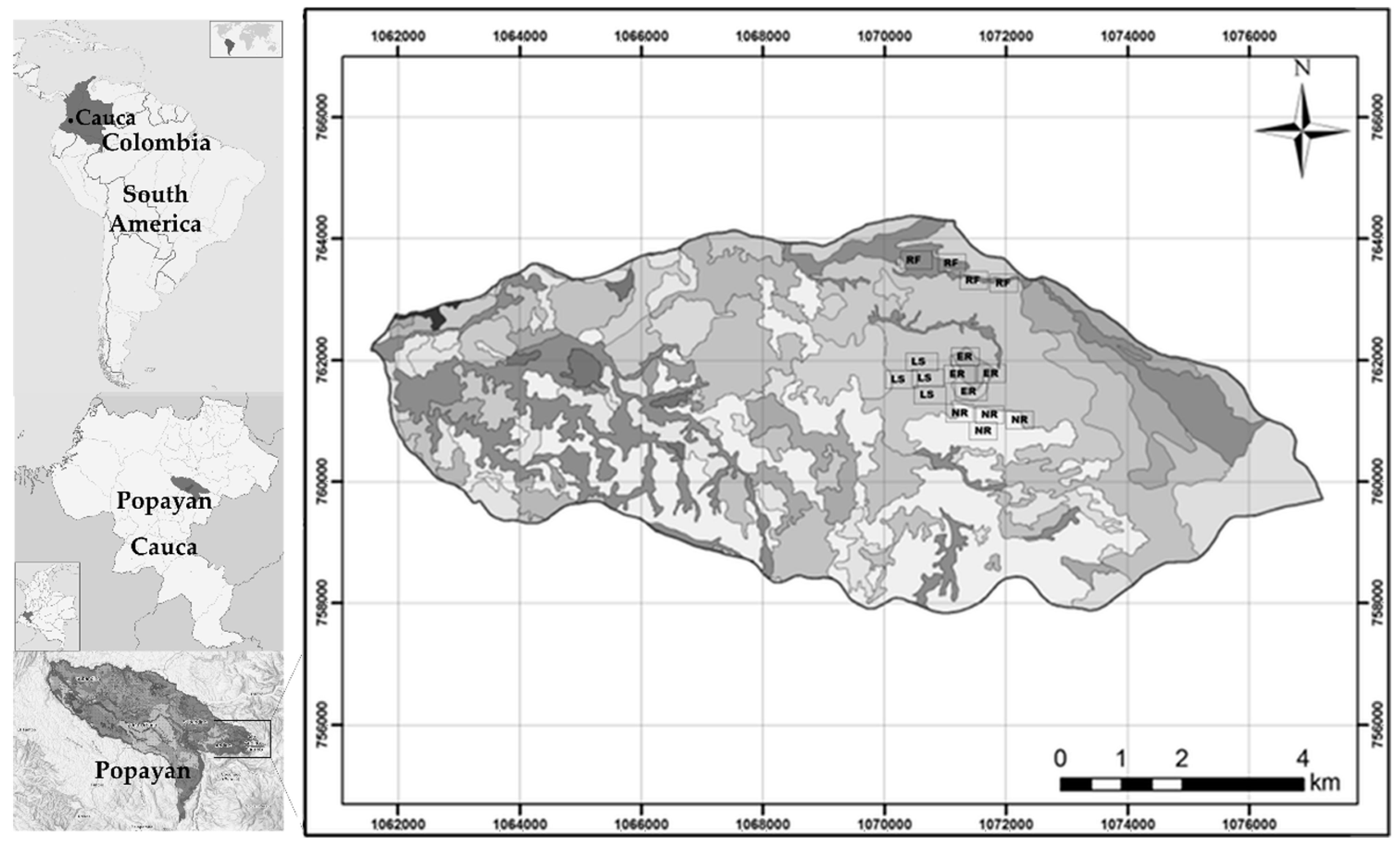
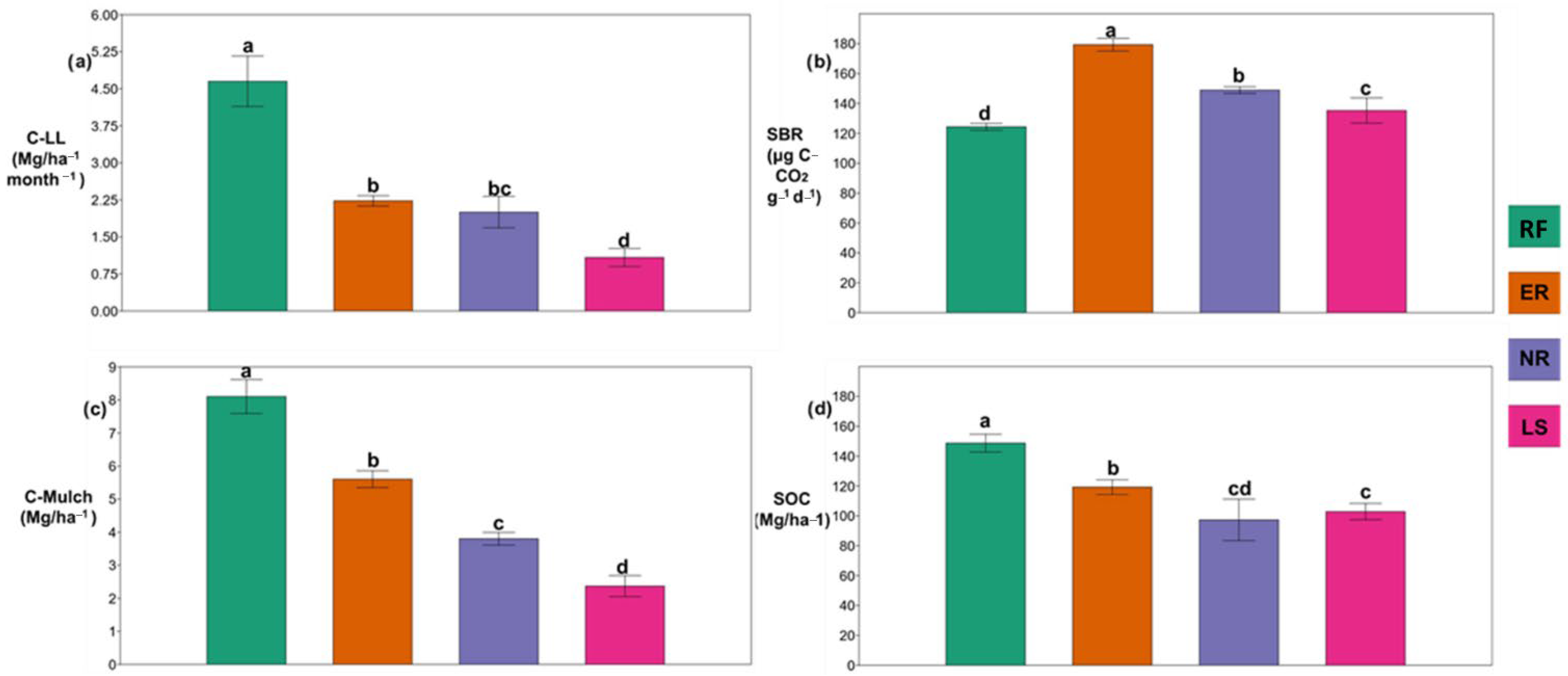
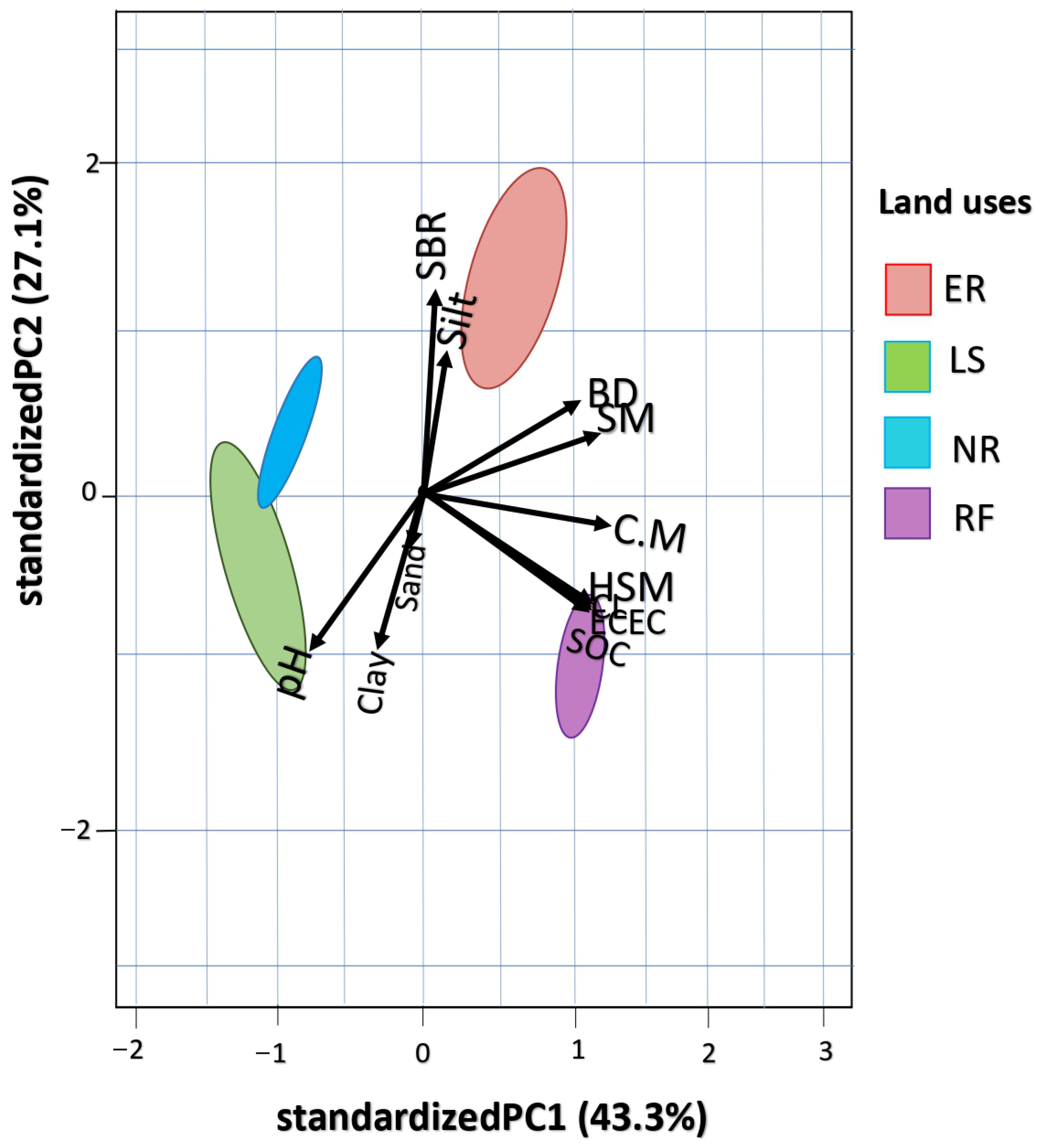
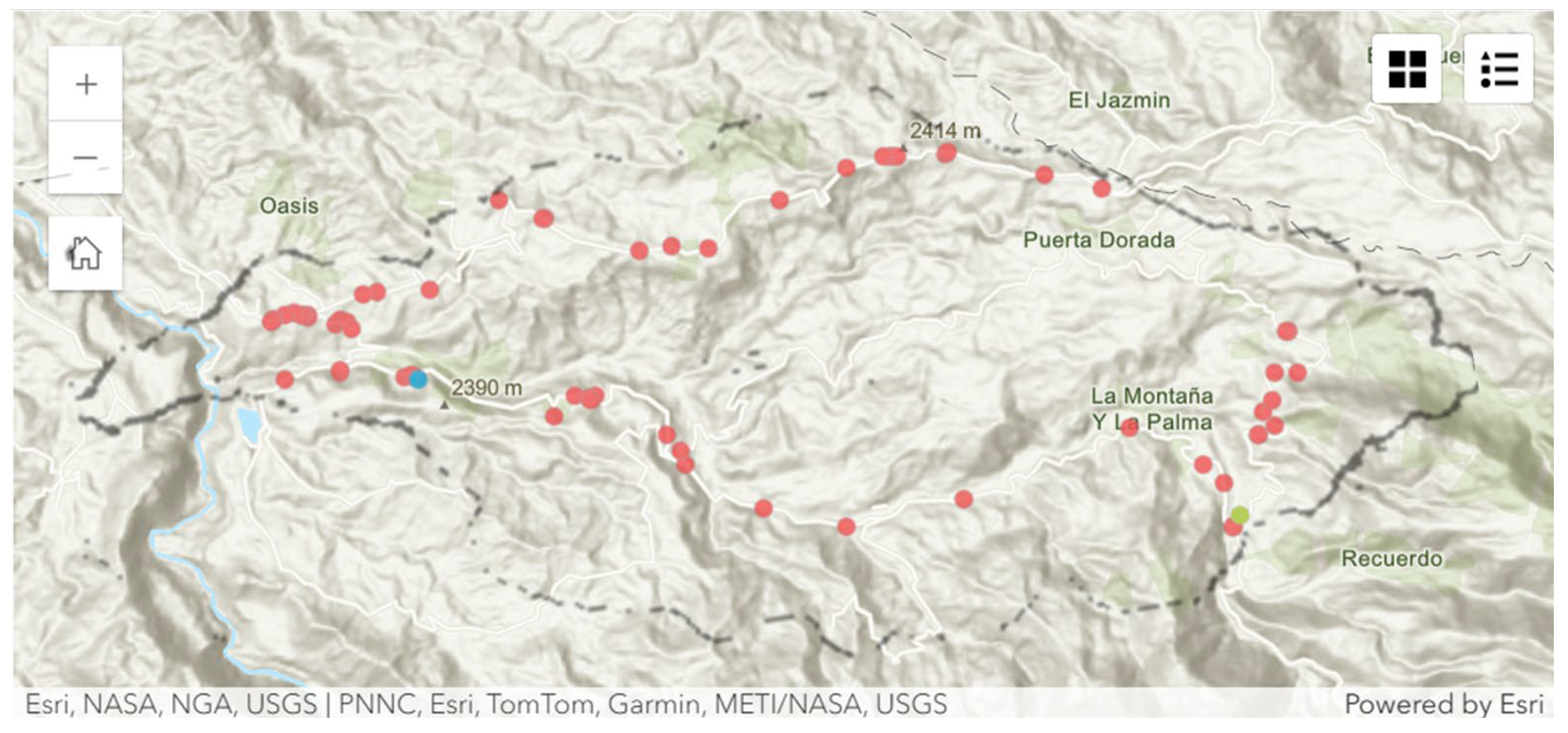
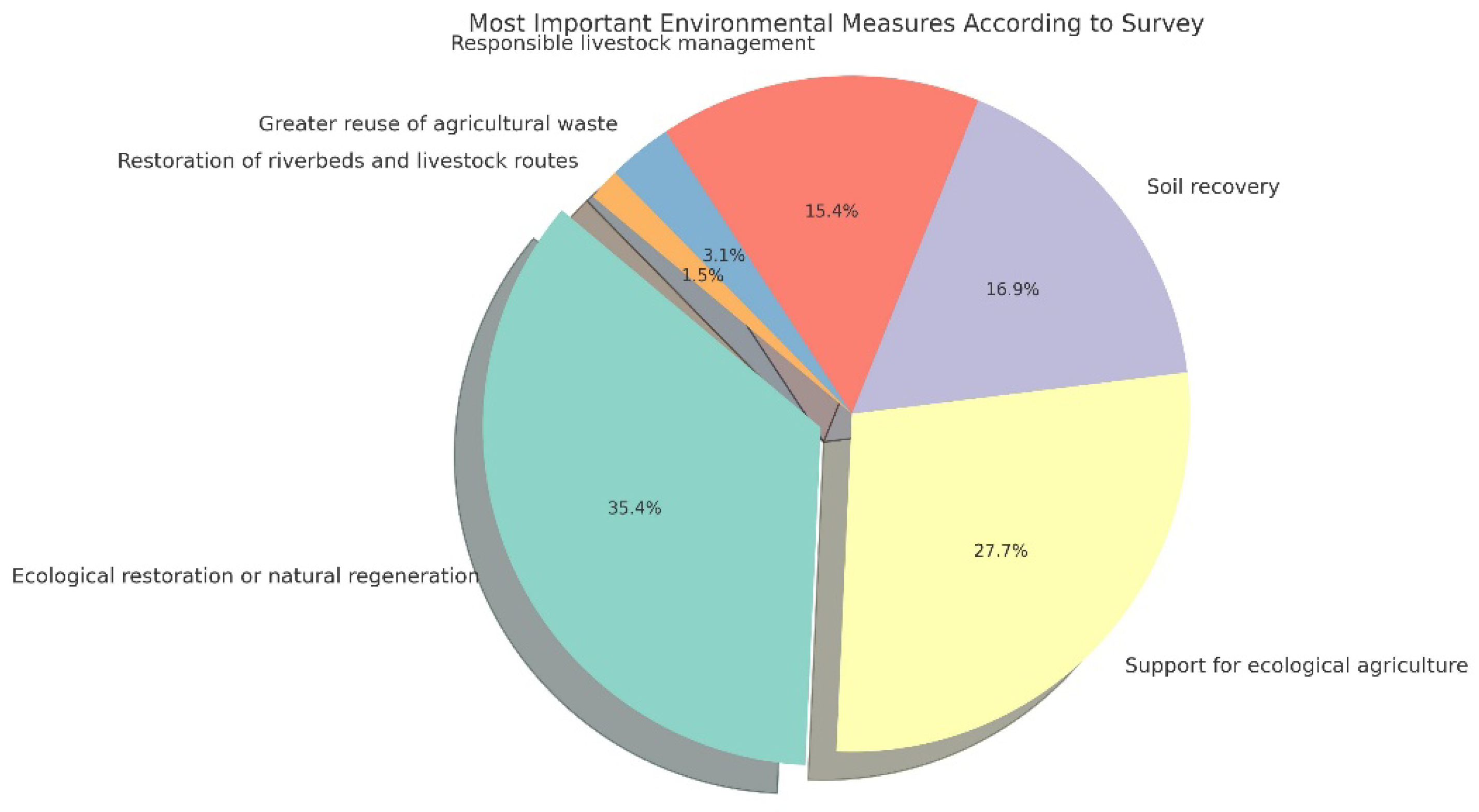

| Plant Cover | |||
|---|---|---|---|
| Variables | RF | ER | NR |
| Basal area/ha (m2) | 15.75 ± 1.03 | 16.33 ± 1.29 | 6.08 ± 1.45 |
| No. trees/ha (DBH > 0.1 m) | 1138 ± 6.49 | 1085 ± 5.57 | 873 ± 3.87 |
| Soil Characteristics | Land Use | ||||
|---|---|---|---|---|---|
| RF | ER | NR | LS | ||
| Physical | BD (g/cm3) | 1.01 a ± 0.01 | 1.06 a ± 0.01 | 0.95 ab ± 0.08 | 0.90 b ± 0.02 |
| HSM (%) | 13.49 a ± 0.40 | 11.32 a ± 0.56 | 10.52 c ± 0.55 | 10.08 b ± 0.49 | |
| SM (%) | 64.96 b ± 0.80 | 65.97 a ± 0.61 | 62.83 c ± 0.25 | 62.75 c ±0.72 | |
| Sand (%) | 73.41 a ± 2.52 | 72.00 b ± 3.01 | 73.50 a ± 2.52 | 73.46 a ± 2.52 | |
| Silt (%) | 21.01 c ± 1.51 | 23.39 a ± 3.03 | 22.40 b ± 2.52 | 21.04 c ± 2.00 | |
| Clay (%) | 5.58 a ± 1.15 | 4.61 ba ± 0.50 | 4.10 b ± 0.50 | 5.50 a ± 1.01 | |
| Chemical | SOC(Mg ha−1) | 148.68 a ± 6.07 | 119.24 b ± 5.04 | 97.30 cd ± 14.13 | 102.85 c ± 5.55 |
| SBR (μg C-CO2 g−1d−1) | 124.31 d ± 2.41 | 179.28 a ± 4.34 | 148.91 b ± 2.31 | 135.25 c ± 8.58 | |
| pH | 4.93 a ± 0.05 | 5.14 a ± 0.05 | 4.98 a ± 0.21 | 5.13 a ± 0.16 | |
| ECEC (meq100 g−1 s) | 3.73 c ± 0.21 | 4.21 b ± 0.21 | 4.38 b ± 0.39 | 5.70 a ± 0.50 | |
| Coefficients: | Intercept | BD | SOC | SBR | CL | C_MU |
|---|---|---|---|---|---|---|
| Low | 32.16 | 18.38 | −0.49 | 0.81 | 24.14 | −34.16 |
| Medium | −32.05 | −18.61 | −1.23 | 0.93 | −19.93 | 20.52 |
| Std. Errors: | Intercept | BD | SOC | SBR | CL | C_MU |
| Low | 331.36 | 311.13 | 6292.85 | 7496.41 | 1131.01 | 548.08 |
| Medium | 299.04 | 245.43 | 6265.70 | 7576.90 | 1017.60 | 1731.31 |
| Residual Deviance: 4.84 × 10−6 | ||||||
| AIC: 24 |
Disclaimer/Publisher’s Note: The statements, opinions and data contained in all publications are solely those of the individual author(s) and contributor(s) and not of MDPI and/or the editor(s). MDPI and/or the editor(s) disclaim responsibility for any injury to people or property resulting from any ideas, methods, instructions or products referred to in the content. |
© 2025 by the authors. Licensee MDPI, Basel, Switzerland. This article is an open access article distributed under the terms and conditions of the Creative Commons Attribution (CC BY) license (https://creativecommons.org/licenses/by/4.0/).
Share and Cite
Mondragón Valencia, V.A.; Figueroa Casas, A.; Macias Pinto, D.J.; Rosas-Luis, R. Soil Organic Carbon Storage in Different Land Uses in Tropical Andean Ecosystems and the Socio-Ecological Environment. Earth 2025, 6, 106. https://doi.org/10.3390/earth6030106
Mondragón Valencia VA, Figueroa Casas A, Macias Pinto DJ, Rosas-Luis R. Soil Organic Carbon Storage in Different Land Uses in Tropical Andean Ecosystems and the Socio-Ecological Environment. Earth. 2025; 6(3):106. https://doi.org/10.3390/earth6030106
Chicago/Turabian StyleMondragón Valencia, Víctor Alfonso, Apolinar Figueroa Casas, Diego Jesús Macias Pinto, and Rigoberto Rosas-Luis. 2025. "Soil Organic Carbon Storage in Different Land Uses in Tropical Andean Ecosystems and the Socio-Ecological Environment" Earth 6, no. 3: 106. https://doi.org/10.3390/earth6030106
APA StyleMondragón Valencia, V. A., Figueroa Casas, A., Macias Pinto, D. J., & Rosas-Luis, R. (2025). Soil Organic Carbon Storage in Different Land Uses in Tropical Andean Ecosystems and the Socio-Ecological Environment. Earth, 6(3), 106. https://doi.org/10.3390/earth6030106






